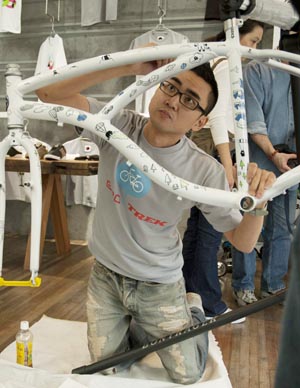Where to go for one-stop solutions
Updated: 2012-02-16 13:08
By Tiffany Tan (China Daily)
|
|||||||||||
How many people does it take to create a website, design a T-shirt, plan a VIP lounge, make product packaging and put together a video installation? James Chang has shown that sometimes you need only one.
In his 15 years as a designer, Chang has taken on numerous jobs in different design fields. He has moved back and forth among interactive, graphic, interior, product and multimedia design. And there's no other place he'd rather be.
"It is how I like to market myself right now - as a one-stop-solution designer," says the 35-year-old creative director of TC Interactive, an e-commerce startup in Zhejiang's provincial capital Hangzhou.
"I can work in all different disciplines, platforms - with architects, interior designers, musicians. You name it."
 |
|
James Chang puts the finishing touches to a bicycle frame during an on-the-spot design context in Shanghai. Photo provided to China Daily |
He later started out creating multimedia products for a print design company in New York. But from the beginning, he always felt compelled to stretch his creative limits and explore the intersections of various design fields.
When he returned to China 10 years ago, the country's relatively young commercial design industry gave him the opportunity to do just that. It also offered him a chance to go beyond multimedia design.
"At the time, this industry was not really clearly defined," he says.
"Clients needed you to do different types of things in different areas of design. Of course, a lot of clients had no idea that different areas actually required different skills. They just figured that if you were a designer you could do all these things. So I had the opportunity to experiment."
The proficiency he developed across design disciplines transformed him into what practitioners call a "crossover designer".
Chang hails from a new generation of versatile designers shaped by advances in technology and connectivity, globalization and the complex social questions of our times. Industry insiders say more such professionals will be needed to work alongside specialist designers in the 21st century.
"Companies like designers who are experts in their field but also can work with other specialists to produce something that is more than a sum of its parts," Dani Salvadori, director of enterprise and innovation at London's Central Saint Martins College of Arts and Design, says in an e-mail.
"These people are described as 'T-shaped people', where the vertical stroke is their specialization and the horizontal stroke is the ability to work with others. The reason is that, in the current market, new products and services require expertise from more than one area."
Having witnessed these changes in the job and consumer markets, some of the world's most renowned design schools began creating courses and programs to train students to think across disciplines.
Parsons New School for Design in New York, for example, now offers a master's degree in "transdisciplinary design". The graduate program, the school says, brings together designers from various fields to look at pressing social issues and offer solutions from multiple perspectives.
"Within the design field, the boundaries between disciplines have been crumbling in lots of ways over the last 15, 20 years," Joel Towers, executive dean of Parsons, says in a phone interview.
"We've completely redesigned the curriculum of Parsons based on our own knowledge of the fact that designers will often have more than one or two or three and upwards of five career trajectories over the course of their lives as professional designers."
China, as a rapidly expanding economy with a budding design industry, can produce its fair share of crossover designers, many foreign observers say. Not many local designers, however, have made the leap.
Chang has his own take on the matter.
"Many people are scared of doing this because they are afraid that they are not going to be good at anything, because they might spread themselves too thinly," he says.
"It takes a lot of courage, for sure."
Today's Top News
Rescuers race against time for quake victims
Telecom workers restore links
Coal mine blast kills 18 in Jilin
Intl scholarship puts China on the map
More bird flu patients discharged
Gold loses sheen, but still a safe bet
US 'turns blind eye to human rights'
Telecom workers restore links
Hot Topics
Lunar probe , China growth forecasts, Emission rules get tougher, China seen through 'colored lens', International board,
Editor's Picks

|

|

|

|

|

|





